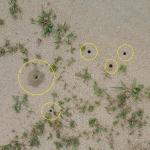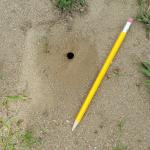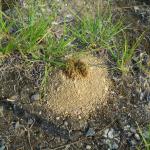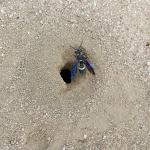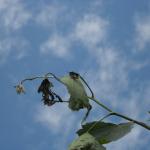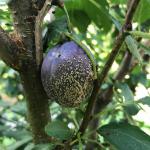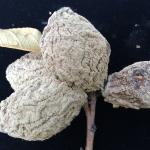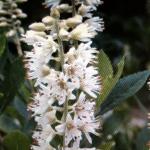A monthly e-newsletter from UMass Extension, published March to October, for home gardeners.
To read the articles in each section of the newsletter, click on the section headings below to expand the content:
Tips of the Month
July is the Month to.....
-
Happy 4th of July! Help celebrate the 4th with a colorful container of patriotic colored plants! Red wax begonia, red geranium, Euphorbia ‘Diamond Frost’, white petunia, blue lobelia, and blue petunia are some of the many red, white and blue annuals to choose from.
-
 Be vigilant and conduct daily tick checks and take precautions against deer ticks when outdoors this summer, especially in wooded or grassy areas and areas with leaf litter, even in the yard. Deer ticks are at the tiny nymph stage, which is about the size of a poppy seed. After feeding, the tick nymph may be the size of a sesame seed (Photo 2 – Deer tick nymph after feeding). Deer ticks are capable of transmitting several diseases, including Lyme disease. Conduct tick checks frequently, especially on children and pets. https://www.cdc.gov/ticks/diseases/index.html
Be vigilant and conduct daily tick checks and take precautions against deer ticks when outdoors this summer, especially in wooded or grassy areas and areas with leaf litter, even in the yard. Deer ticks are at the tiny nymph stage, which is about the size of a poppy seed. After feeding, the tick nymph may be the size of a sesame seed (Photo 2 – Deer tick nymph after feeding). Deer ticks are capable of transmitting several diseases, including Lyme disease. Conduct tick checks frequently, especially on children and pets. https://www.cdc.gov/ticks/diseases/index.html -
If you do find a tick, you can send it to the UMass Laboratory of Medical Zoology (LMZ) and have it identified and tested – info at https://www.tickreport.com; click on the red “Test a Tick” button for more information. The cost for this testing is currently being subsidized by a grant from the state’s public health department and the Centers for Disease Control and Prevention (CDC), which will allow the LMZ to provide tick testing for just $15 for Massachusetts residents for a limited time until the subsidy runs out.
-
Vegetables need to receive water on a regular basis; don’t let the soil become too dry between waterings. Maintaining even soil moisture, especially during hot, dry weather, helps tomato plants avoid blossom-end rot, helps cucumbers avoid tasting bitter and helps to keep carrots and tomatoes from splitting.
-
Long season crops like tomatoes, corn, pumpkins, cucumbers, melons, squash, corn, potatoes, onions and peppers usually benefit from applying a light application (side-dressing) of a complete granular garden fertilizer such as 10-10-10 around each plant.
-
Continue to plant or sow seeds of arugula, parsley, beans, lettuce, kohlrabi, arugula, carrots, mesclun mix, mustard greens, Swiss chard, dill, cilantro and beets.
-
Plant plants of broccoli, Brussels sprouts, cauliflower, collard greens, kohlrabi, and cabbage for a fall harvest.
-
Mosquitoes are numerous and bothersome in many areas this year, so consider applying a repellent when working or playing outdoors. Remember to empty containers of standing water, prime breeding habitat for mosquitoes, or treat the water in bird baths, rain barrels, plant saucers, etc. with Bacillus thuringiensis israelensis (Bti), which will kill the mosquito larvae. Bti is a naturally-occurring soil bacterium registered for control of mosquito larvae.
-
Continue to weed gardens, especially vegetable gardens. It is not too late to apply a layer of organic mulch such as hay or straw, if not already done. Mulch helps to deter weeds, moderate soil temperature, and reduce soil moisture loss.
-
Be on the lookout for wasps like the ground-nesting yellow jacket, which if stepped on or disturbed, may result in hundreds of attacking, stinging wasps. https://ag.umass.edu/fact-sheets/yellow-jackets Also, be on the lookout, especially while pruning trees and shrubs, for the grayish, football shaped nests of the bald-faced hornet, which are actually wasps. If disturbed, they too may swarm and sting. http://ento.psu.edu/extension/factsheets/baldfaced-hornet
-
Cut off the dead flowers (deadheading) on annuals like snapdragons, zinnias, marigolds, petunias, geraniums, dahlias, geraniums, lantana, etc. It not only keeps the plants looking more attractive, but it also doesn’t allow the plant to produce seeds, resulting in more growth and more flowers.
-
Not all insects are harmful to plants, including some wasps, flies and beetles, which in addition to butterflies, may be good pollinators. To learn more about garden pollinators, see this UMass Extension fact sheet: https://ag.umass.edu/home-lawn-garden/fact-sheets/gardening-to-support-pollinators
-
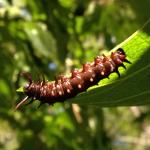 Not all caterpillars are bad. Learn which caterpillars are responsible for the beautiful butterflies we see before applying an insecticide or hand-picking and killing. This caterpillar is the larvae of the beautiful Pipevine swallowtail.
Not all caterpillars are bad. Learn which caterpillars are responsible for the beautiful butterflies we see before applying an insecticide or hand-picking and killing. This caterpillar is the larvae of the beautiful Pipevine swallowtail. -
One of the best tools for the yard is a rain gauge. Plants need water and a rain gauge can be the perfect reminder to let you know it is time to water the vegetables, containers, or trees stressed last summer by drought and or defoliation from caterpillars. Most plants need at least an inch of water per week, (more often if there is a drought) applied over the root system. If the rain gauge is checked often and it is empty because there was no rain that week, then maybe it is time to water those plants.
-
Bt (Bacillus thuringiensis) is a biological insecticide that is used to manage caterpillar pests such as the imported cabbage worm on cabbage, broccoli, cauliflower and other cole crops, and to manage tomato hornworms on tomatoes. Bt is most effective on small larvae.
-
Check the undersides of tomato leaves for the bright green tomato hornworm caterpillar which may eat foliage, stems and sometimes even young tomatoes. This caterpillar is often difficult to see, as it blends right in with the green foliage. Monitor plants often and try to handpick the caterpillars when they are small. If found, handpick and destroy any caterpillars. Applications of Bt (Bacillus thuringiensis), according to the label directions, will help deter this pest.
-
Plants in containers and hanging baskets usually dry out sooner than plants in the soil, especially as the plants grow larger and use more water. Continue to water on a regular basis, especially as the days become warmer and, if possible, place plant saucers under the containers to help retain moisture.
-
Continue to fertilize plants in containers and hanging baskets about every week and a half to two weeks with a dilute solution of water soluble fertilizer or add a slow release fertilizer to the soil.
-
Spring flowering trees and shrubs like rhododendrons, forsythia, lilacs, dogwoods, redbuds, azaleas, witchhazel, etc. produce flower buds for next year right after they have finished blooming. Pruning now will likely remove the flower buds that have formed for next year, so unless necessary, avoid pruning them until immediately after blooming next spring.
-
It’s almost blueberry picking time! Blueberries do not ripen as soon as they turn blue but after they have been on the bush for a few days to a week. Look at the blueberries all the way around and under to be sure they are blue all the way around. The bluer the berry, the riper and sweeter it should be.
-
July is a good time to divide bearded iris, which usually needs to be divided about every three years. When digging and dividing up a clump of iris, save only the young healthy pieces of rhizome (those at the outer portions of a clump); discard any that appear diseased or have Iris borer.
Deborah C. Swanson, Horticulturist
Timely Topics
Cucurbits
Cucurbit is short for plants that are in the Cucurbitaceae family, sometimes referred to as the gourd family. This family includes more than 900 species in 125 genera, several of which are important in the vegetable garden and as edible seeds, oilseeds, ornamentals, and even fiber. Cucumbers, gourds, melons, pumpkins and squashes are some common vegetable garden crops in the cucurbit family. The majority of these plants are trailing or climbing herbaceous annuals. They are of tropical and subtropical origin and are all frost sensitive. The plants are primarily monoecious, which means they have separate male and female flowers on the same plant.
The genus Cucurbita contains three common vegetable garden species:
1) C. maxima - banana, buttercup, hubbard, and kabocha squashes
2) C. moschata - butternut squash, calabaza, Long Island cheese pumpkin, and tromboncino
3) C. pepo - acorn squash, gourds, pumpkins, and summer squashes
All three originated in South or Central America and represent some of the oldest domesticated plants. C. pepo is believed to have been domesticated in southern Mexico 8,000 – 10,000 years ago.
The Cucurbita genus contains a great amount of diversity and fruit are often referred to as “gourds” (non-edible fruit), “pumpkins” (round edible fruit), and “squash” (edible non-round fruit). The terms are not necessarily clear cut. For example, pie pumpkin in a can is often made from squash; the USDA does not distinguish between pumpkin and squash.
Cucumbers, Cucumis sativus, are another familiar vegetable from the Cucurbitaceae family commonly grown in the garden. Cucumbers originated in South Asia and have been in cultivation for nearly 3000 years. Cucumbers have been utilized around the world, which has resulted in diverse forms and flavors. In North America, most are familiar with the types we commonly grow which include slicing, pickling, and burpless cucumbers. Slicing cucumbers are grown primarily to eat fresh in the unripe green form; slicers are generally long and have smooth skin. Pickling cucumbers are grown for pickling in brine with sugar, vinegar and other spices. Though any cucumber can be pickled, most pickling cucumbers have been bred specifically for the purpose with uniformity in length-to-diameter ratios and are shorter than slicers. Gherkins are basically baby pickling cucumbers. Burpless cucumbers are parthenocarpic, meaning they set fruit without pollination; they are seedless, have a thinner skin, and are typically longer than the traditional slicer.
Cucumbers are naturally monoecious (having separate male and female flowers on the same plant), but through breeding, gynoecious (having predominately female flowers) and parthenocarpic (set fruit without pollination) varieties have been developed. This can be important to know in the garden and would suggest seeking out monoecious varieties for the home garden. Gynoecious varieties can be an issue if no male pollinator plant is nearby to provide a source of pollen. Parthenocarpic varieties can also be an issue, especially if you are growing other monoecious varieties nearby, as they may then get pollinated and develop fruit that produce seeds and will not maintain the desired skinny shape.
Cucumis melo, muskmelons, are another species of Cucurbit which seem to have near endless variation. Muskmelons include canary, cantaloupe, casaba, charentais, crenshaw, galia, and honeydew melons which are among just a few of the more common types available. Watermelon, a member of the Cucurbitaceae and is not Cucumis melo but Citrullus lanatus, has similar growing needs. Melons are less often grown in home gardens than the above-mentioned crops. Though a vine ripened melon is of incomparable quality, they can be difficult to grow in the Northeast as they generally require a long hot growing season with plenty of sun, which is not guaranteed in the Northeast.
Some other notable Cucurbits include mouse melon, luffa and bottle gourds. Mouse melons (Melothria scabra) are small, about the size of a large grape, and look like tiny watermelons with green and white striped skin. The fruits have a cucumber-like flavor and provide a novelty item in the garden. They produce large amounts of fruit on easily climbing vines. Luffa (Luffa spp.) are eaten in the unripe stage in some cultures, but they are known here primarily for their fibrous fruit that, when mature, can be used to produce luffa sponges. They require a longer season of 150 plus days to harvest. Bottle gourds (Lagenaria siceraria) are another interesting and fun crop to grow. The fruits, like luffa, are edible when young but are primarily grown to maturity and then dried. The dried fruits make long lasting decorations or the iconic gourd bird house.
Growing Requirements
The growing of cucurbits is fairly basic - they all require ample sunlight, moisture and space. Space can be a considerable constraint. Many varieties have been bred to have a bush habit and these may be good solutions where space is limited. Many cucurbits readily climb with the aid of tendrils and you may be able to take advantage of growing them up a trellis in your garden; just beware that large fruit might need additional support.
All cucurbits are frost sensitive and should not be planted until soil temperatures reach about 60 degrees F; for melons and cucumbers, even higher soil temperatures are desirable. Consider using plastics that can provide greater soil temperatures. For example, IRT plastic allows a 7-10 degree F bump in soil temperature.
Cucurbits are often direct seeded; however, it is possible to use transplants. If using transplants, they should only have 1-3 true leaves at time of transplant. As the plants get older, they suffer more from transplant stress.
The large vines and potentially large fruit require ample moisture and fertility. Do a soil test before planting to provide optimal conditions and make sure you have a way to irrigate when natural precipitation is inadequate.
Pests and Problems
Cucurbits are not without pests. Make sure you take the time to correctly identify any pests you have. Striped cucumber beetle is one of the more common cucurbit pests. These yellow and black striped beetles feed on cucurbit plants early in the season and can kill seedlings or even young plants when populations are high. The larvae also feed on the roots of cucurbits. Striped cucumber beetle also vectors a disease organism called bacterial wilt, which can be extremely damaging to cucumber and muskmelons, causing a collapse and wilting of vines.
Squash vine borer is a colorful moth that mimics a wasp or hornet. This insect emerges in mid/late June and lays eggs at the base of susceptible cucurbits - typically larger stemmed squashes and pumpkins are most susceptible (C. maxima and C. pepo). The eggs hatch and the larvae bore into the stems, where they feed. A pulpy frass (insect excrement) can often be found at the base of stems with squash vine borer in them. Summer squashes are particularly susceptible and often wilt and collapse from the damage. More vigorous vining crops such as pumpkins that root at the nodes can survive the damage.
Powdery mildew is a disease that often attacks cucurbits. It can be easily diagnosed by the white powdery masses found on the upper or lower leaves, petioles and stems. This disease often shows up in mid-summer. Unlike many other fungal plant diseases, powdery mildew can infect without the leaves being wet as long as there is high humidity. Powdery mildew along with other pests often leads to a decline in vigor and poor fruit quality after midseason.
These are not the only pests of Cucurbits, but are some of the more common ones seen in the home garden. More information about the growing of specific cucurbits and the management of diseases and insects can be found in these fact sheets.
Cucumber Growing Tips
Melon Growing Tips
Pumpkin & Squash Growing Tips
Summer Squash Growing Tips
Disease Management in the Home Vegetable Garden
Insect Management in the Home Vegetable Garden
Russ Norton, Cape Cod Cooperative Extension
News for Gardeners
Not All Wasps Sting (People): Meet the Smokey-Winged Beetle Bandit
It can often be very easy to judge a book by its cover, especially when it comes to insects that could potentially sting us. I’m sure many of us remember the very first time we were stung. For me, it was on the tip of my index finger while picking raspberries at my grandmother’s house at the ripe old age of 6 or so. I believe I ran to her, exclaiming that a bee had stung me, when now I realize the likely culprit was probably a yellow jacket. At the time, I felt unfairly victimized. Now, I realize I was pretty lucky – one of my brother’s first run-ins with a stinging insect was also likely with yellow jackets – multiple – that somehow got pinned beneath his shirt. He was stung multiple times, rolling on the ground in a reflex reaction to get rid of them.
It can be difficult, if not impossible, to forget these encounters. That is ok – it is good to learn to avoid stinging insects, especially those that can aggressively defend their homes and sting multiple times. However, it is good to know which species of wasp you have encountered before you make any decisions to disturb or otherwise manage them. Certain wasp species are completely incapable of stinging humans, and this includes Cerceris fumipennis, or the smokey-winged beetle bandit. C. fumipennis is not only completely innocent of stinging people, but this fairly large (and possibly intimidating if you do not know better) wasp has aided in the detection of the invasive emerald ash borer (EAB), Agrilus planipennis. The emerald ash borer, or green menace to some, is now present in at least 33 states including Massachusetts, and is threatening our North American species of ash (Fraxinus).
C. fumipennis females are experts at hunting adult Buprestidae, or the family of beetles known as the jewel beetles, also known as the flatheaded borers. This is the family to which the emerald ash borer belongs. In addition to hunting and capturing our native jewel beetles, C. fumipennis will also utilize adult EAB. It has also been documented that they will hunt beetles in other families, like the Chrysomelidae (leaf beetles), but to a lesser extent than the Buprestidae.
But where will you find this wasp? The smokey-winged beetle bandit is a solitary wasp, meaning that each female tends her own nest separately, but they nest in groups or aggregations. These groups can be small (5 - 10 nests) or they can be very large (700+). You can find C. fumipennis nesting in hard-packed sandy soils with sparse vegetation in areas of full-sun. In many cases, we have made perfect habitats for these wasps by constructing baseball fields. While rounding the bases or standing on the pitcher’s mound, you may notice nests.
Each female tends a nest with a perfectly round entrance hole that leads straight down into the ground, if the nest has not been disturbed in some way. This opening is large enough to stick a pencil in. It is surrounded by a tumulus, or volcano-like mound of sand, making each nest look reminiscent of a giant anthill. Within that nest is a tunnel leading to individual cells. Each cell awaits a paralyzed jewel beetle prey provisioned by the adult female, with the end goal of laying a single egg on a beetle within each cell. The egg eventually hatches and the resulting young wasp larva consumes the paralyzed beetle prey. Female young may be given more beetles than eggs that will develop into males, as females are larger.
The immature wasps spend all of their time in these subterranean nests, hatching from the egg and undergoing their larval and pupal stages below ground. The winter is spent below ground, and adult wasps emerge the following summer. In my experience studying this insect in Maine, C. fumipennis aggregations typically become active around the 4th of July. For Massachusetts, adult emergence typically occurs a bit earlier, by mid-June. Therefore, if a ballfield near you has this insect present, the adult wasps should be active and visible at this time.
Other areas where C. fumipennis has been found nesting include the edges of dirt roads, fields that are used for parking which create hard-packed soils sparse with grass, gravel pits, and sandy areas between paver stone paths or campsites.
So other than this being an incredibly cool, native species of wasp – what is the takeaway message here? Not all ground nesting wasps sting people (although some ground nesting Hymenoptera do), so it is important to recognize which before we decide we cannot coexist with them. If you have the smokey-winged beetle bandit living near you, try to let the wasps live and do their thing. They will return the favor.
Are you interested in volunteering as a “Wasp-Watcher”, and learning how to use C. fumipennis to detect invasive wood-boring beetles such as the emerald ash borer? Have you found a large aggregation of these wasps and want to report it to other Wasp-Watchers in Massachusetts? If so, please contact Javier Marin, Forest Pest Outreach Coordinator with the MA Department of Agricultural Resources at javier.marin@state.ma.us. He has graciously offered to visit MA towns and show potential Wasp-Watchers how to set up a monitoring program, what to look for, and what materials will be needed to work with these insects to monitor for non-native pests.
How Do You Identify Cerceris fumipennis?
One quick and easy way is if you find jewel beetles lying on the ground, outside of nearby nests. On occasion, these wasps, for reasons yet unknown, drop their jewel beetle treasures before they bring them underground. C. fumipennis is the only species of buprestid-hunting Crabronidae (solitary wasps) occurring in eastern North America.
C. fumipennis wasps are rather large, usually about the size of common yellow jacket wasps. They have dark, smoky, blue/black wings and mostly black bodies- with the exception of a few yellow markings. There is one conspicuous, broad, creamy yellow band on the upper abdomen and the female wasps have 3 yellow markings on their faces between the eyes, while the males have only 2 in this area. Believe it or not, it is easy to see these yellow markings on the face of the wasps, especially when they are looking out of their nest openings in the morning before taking flight.
Tawny Simisky, UMass Extension Entomologist
Trouble Maker of the Month
Brown Rot of Stone Fruits Caused by Monilinia fructicola
Brown rot is a disease that affects the shoots, foliage and fruit of hosts in the genus Prunus (cherry, plum, apricot, nectarine and peach). Blossom and foliar wilt, fruit rot, oozing stem cankers and branch dieback can result from infection.
The fungus often becomes established on blossoms soon after germination and then lingers in the tree canopy all season long. Whenever environmental conditions are favorable, Monilinia produces large masses of spores that are splashed or washed onto twigs and fruit, initiating new disease centers. Infected blossoms and fruit often have a very conspicuous, brown-colored, powdery coating present. These are long chains of lemon-shaped spores produced by the fungus. Stem cankers are accompanied by copious production of gum around the wound.
All Prunus species produce amber-colored gum in response to injury (biotic or abiotic) on woody parts, a process that is known as gummosis. The pathogen can overwinter within stem cankers, blighted leaves and fruit, especially fruit that has fallen to the ground around the base of the tree. Rotted, diseased fruit (sometimes known as “mummies”) may be held in the canopy, providing a large inoculum source the following season if they aren’t removed.
Prune and discard the blighted leaves, fruit and stems to reduce Monilinia inoculum within the tree canopy. Also, prune to maintain an open crown that maximizes sunlight on each fruit-bearing branch and improves air circulation. This will promote foliage drying and limit the environmental conditions conducive for infection. If spring conditions are particularly wet, then chemical management may be necessary to control brown rot.
Nicholas J. Brazee ,UMass Extension Plant Pathologist
Plant of the Month
Clethra alnifolia, Sweet Pepperbush or Summersweet Clethra
Unlike the spring, when there are hundreds of species of woody plants in bloom, mid to late summer may prove to be more of a challenge for finding colorful woody flowering trees and shrubs, but they are there.
Actually, there are a number of woody plants that bloom, or begin to bloom, in July: Oxydendron arboreum (sourwood tree - native); Albizia julibrissin; Aesculus parviflora (bottlebrush buckeye - native); Indigofera kirilowii (indigo); Indigofera amblyantha (Chinese indigo); Hydrangea macrophylla; Hydrangea quercifolia (oakleaf hydrangea – native); Hydrangea arborescens (smooth hydrangea - native); Hydrangea paniculata (panicle hydrangea); and Clethra alnifoilia.
Clethra alnifoilia, Sweet Pepperbush or Summersweet Clethra, is an outstanding native shrub for mid-late summer bloom, as it begins to bloom in mid-late July into August. With about four weeks of bloom, this makes it a great Plant of the Month for July!
Clethra alnifolia is a multi-stemmed deciduous shrub standing 4-8 feet high with a width that is equal to that or greater. It is a shrub with a suckering habit and is able to spread and colonize wide areas, especially in moist soil conditions. Preferring full sun to partial shade, it is site adaptable, growing in sun or shade, is tolerant of seaside conditions, and although it favors acidic, moisture-retentive organic soils, it is fairly drought tolerant. It has no significant insect or disease problems and is winter hardy to zone 4.
If those aren’t enough favorable attributes to select Clethra alnifolia, consider that the individual creamy-white, 1/3 inch, star-like flowers are arranged in upright racemes waving above the foliage like candles. These flowers are not only lovely to look at, but they are also exceedingly fragrant and flower for 4-6 weeks, filling the summer landscape with delightful perfume. Bees, butterflies and hummingbirds are attracted to the flowers, which provide nectar for pollinators and a benefit to wildlife.
Summersweet Clethra produces slightly glossy, medium to deep green leaves, 1 ¼ to 4 inches long and ¾ to 2 inches wide. In the fall, the foliage turns a rich butter-gold yellow, adding terrific color to the autumn landscape.
There are numerous cultivars of Clethra alnifolia, including more compact cultivars like ‘Hummingbird’, ‘Sixteen Candles’, and ‘Compacta’ (‘Nana’), or pink flowering cultivars like ‘Ruby Spice’ (a Cary Award winner), ‘Rosea’, and ‘Pink Spires’.
Summersweet Clethra may be used in a shrub border, naturalized area, shade gardens, seaside gardens, urban areas, wet areas, mass planting, woodland gardens, etc. Its many attributes - native plant, fragrant flowers, long bloom period, site adaptability, no significant pest problems, cold hardiness, colorful fall color, pollinator plant, low maintenance - make Clethra alnifolia a good choice for the summer.
Deborah C. Swanson, Horticulturist
Additional Resources
Landscape Message - for detailed timely reports on growing conditions and pest activity
Home Lawn and Garden Resources
Find us on Facebook! www.facebook.com/UMassExtLandscape/
Follow us on Twitter for daily gardening tips and sunrise/sunset times. twitter.com/UMassGardenClip
Diagnostic Services
The UMass Extension Plant Diagnostic Lab provides, for a fee, woody plant and turf disease analysis, woody plant and turf insect identification, turfgrass identification, weed identification, and offers a report of pest management strategies that are research based, economically sound and environmentally appropriate for the situation. Accurate diagnosis for a turf or landscape problem can often eliminate or reduce the need for pesticide use. Sampling procedures, detailed submission instructions and a list of fees.
The UMass Soil and Plant Nutrient Testing Laboratory at the University of Massachusetts Amherst provides test results and recommendations that lead to the wise and economical use of soils and soil amendments. The Routine Soil Analysis fits the needs of most home gardeners. Sampling procedures plus the different tests offered and a list of fees.
Spread the Word!
Share this newsletter with a friend! New readers can subscribe to our Home Gardener E-Mail List.
